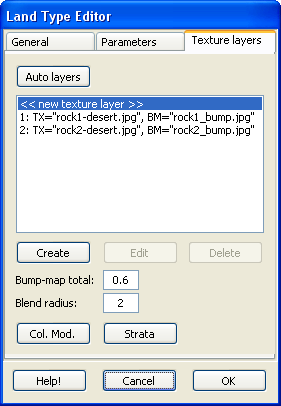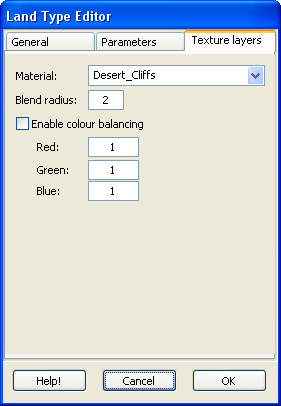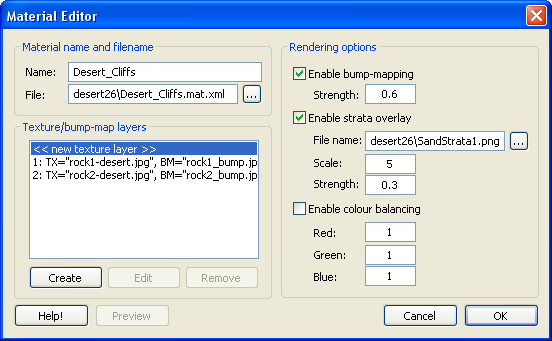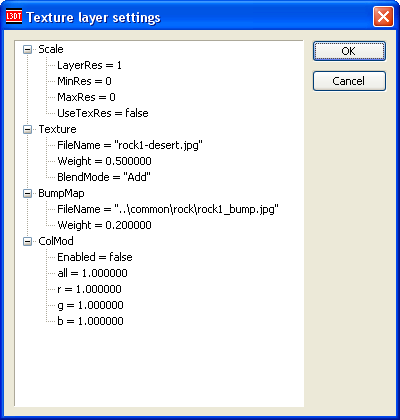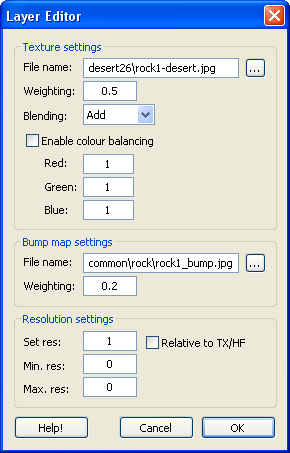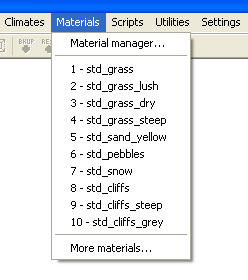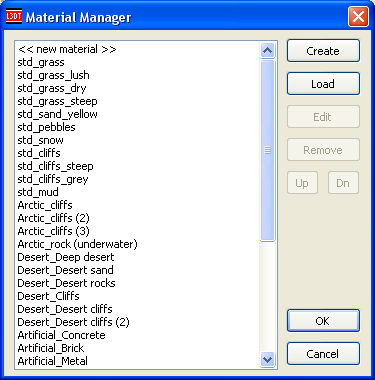Revision to climate texturing
Hi All,
In the latest release candidate of L3DT Pro (v2.5.2.20), there have been some improvements to the way textures and land types are handled. In particular, this updated introduces the concept of materials. Materials are the new containers for all the 'appearance' settings that were previously stored in each land type, such as bump-maps, textures, colour modifiers, strata layers, etc. All these settings were previously accessible via the 'textures' tab in the land type editor (below left). Now, in the land type editor, you simply pick the material used to texture the land type (below right).
To edit the texturing/bump-map information, we use the new material editor dialog (shown below). I hope you will find to be a more intuitive and streamlined interface than the crowded and complex 'textures' tab in the land type editor used previously.
Also, the old user interface for editing texture layers (below left) has been replaced by a new, purpose-built texture layer editor (below right). This also should be much more intuitive for users.
Material menu and manager
To access the material editor we now use the 'Materials' menu and the 'Material Manager' dialog box, just like we do with climates (see below).
Key advantages
The key advantages of the new material system are:
- The climate/material user interface is easier to use.
- Different land types can 'share' the same material, so you don't have to keep re-creating the texture settings for similar land types.
- Because materials can be shared between land types, generation of normals/light/texture maps is more memory-efficient (i.e. texturing in L3DT will use less RAM than before.)
- The material-based texturing system provides more 'headroom' for improvements, such as those listed below.
Further improvements
This is not the final implementation of the material editor or climate/material system, and several improvements are planned for the next release (L3DT v2.6). These include:
- A 'preview' option in the material editor to show you what the material will look like in your final texture 1).
- Support for mosaic textures and bump-maps in materials.
- Faster normal/light/texture map rendering using pre-blended multi-resolution materials ('supertextures').
Visible difference?
The new material system will not affect the appearance of the textures or light maps generated by L3DT. This change is all about making the texturing system more efficient, including a more efficient user interface, and a more memory-efficient texture management system.
Backwards compatibility
I've been very careful to ensure that backwards compatibility with climates from L3DT v2.4 and onwards has been maintained. When loading '.cli.xml' climate files produced in L3DT 2.4 or later, the new climate loader will automatically generate the material definitions, and convert the climate to the material-based system.
However, the old-style '.cli' climates from L3DT 2.3 and earlier are no longer supported. These files were declared deprecated and marked for removal with L3DT release 2.4, back in June of 2006. If you have any old-style '.cli' climates that you'd like to migrate to the new '.cli.xml' format, you have one last chance to do so: Load the climate file in L3DT release 2.5b to convert it to a new '.cli.xml' file.
Just to reiterate, L3DT v2.6 will not load '.cli' files anymore.
Help and documentation
You'll note that the material and layer editors, I've added 'Help!' buttons to the lower-right corners. These buttons will open a web browser and go to the relevant pages in the user guide…once they've actually been written.
Feedback
If you would like to comment on the changes, please do so in this forum thread.
Cheerio, Aaron.
